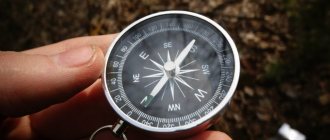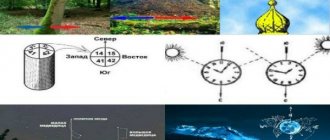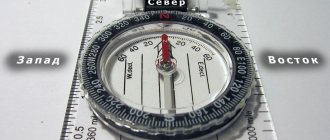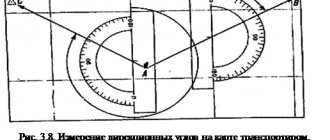Published Olga at 06/07/201906/07/2019
The North Star is probably known to everyone. It is always located on one part of the sky and allows you to accurately determine north. If you know exactly how to find the North Star by its appearance or the location of other constellations, you can navigate the area quite accurately, even without a compass or other instruments at hand.
This article will discuss the main ways to search for this bright point in the sky of the Northern Hemisphere. We hope that these tips will help you accurately and correctly navigate the space.
A way to find the North Star in the sky
North is determined not only by one point, but also by the location of other constellations. Unfortunately, this method of orientation requires certain knowledge of astronomy. Moreover, it is associated with a certain risk: if you incorrectly determine the location of the constellation or completely confuse it with another, you may go in the wrong direction (Figure 1).
Figure 1. The easiest way to find the North Star
To prevent this from happening, orienteering experts still advise finding the North Star in the night sky and only using it to determine the direction of movement.
Fortunately, you don't need any maps or compasses to find it. It is the brightest in the sky, and is located at the end of the Polar Bear. Moreover, if all other constellations gradually move across the sky, then this one hangs motionless, being their center.
Features and description of the constellation
In order for the North Star, the brightest in the sky, to really help you navigate in space, it is advisable to find out more information about its appearance and features (Figure 2).
Everyone knows that it is brighter than other heavenly bodies. But there are many other bright points in the night sky that can mislead a beginner.
If you carefully observe the night sky, you will notice that all the constellations are gradually moving. This occurs due to the rotation of the Earth around its axis. The North Star, unlike all the others, is practically motionless. It is located in the center of the other clusters. It is thanks to this feature that the brightest luminary always points to the north.

Figure 2. The North Star always points north
Finding the right direction takes just a few simple steps. You need to find it in the sky and draw a visual vertical line from it to the visible horizon. North will be at the intersection. The south, accordingly, will be located behind the viewer, the east - to the right, and the west - to the left.
Game Avataria: Physics answers - B
? In
what year was the mercury thermometer invented?
✓
1714.
* * *
? Is
it true that if you shake a burnt-out light bulb, then suddenly the “revived” light bulb begins to shine even brighter?
✓
Yes.
* * *
? Is
it true that the less the action of another body on the cart, the longer the speed of its motion is maintained and the closer it is to uniform?
✓
Yes.
* * *
? In
nature, substances are found in three states: solid, liquid and...
✓
Gaseous.
* * *
? Take
two identical pieces of ice and place them on the table.
The first one was wrapped in wet newspaper. Which piece of ice melts slowest? ✓
Wrapped in newspaper.
* * *
? Is
the steam white or transparent?
✓
Transparent.
How to find the North Star by Ursa Major
The easiest way to find the North Star in the night sky is Ursa Major. Of course, there are a lot of visible points in the sky, but in the absence of artificial light sources, they will look much brighter than in the city. Finding the constellation Ursa Major is not difficult, since its bucket is visible in the sky all year round and has a characteristic shape, so even beginners can notice the cluster of night stars (Figure 3).
Outwardly, it seems that Ursa Major consists of only seven points. In fact, there are many more of them, but the brightest are those that give the constellation the shape of a bucket.

Figure 3. The easiest way to find the brightest star is by looking at the Ursa Major bucket
To determine the location of the bright point, you need to find the two rightmost luminaries of the “bucket”. From them you need to lay a horizontal line, and your gaze will rest on a bright point of light. They stand out strongly against the background of other, smaller luminaries. In fact, the North Star is part of the constellation Ursa Minor. It also resembles a ladle in shape, although it is much smaller in size and visually seems to be turned upside down in relation to the Big Dipper. At the end of the “handle” of the second “bucket” is the North Star.
By the way, the location of the constellations largely depends on the season. In winter, the Big Dipper seems to stand on its “handle”, shifting to the east, in the spring it is almost at the zenith, and in the summer it completely moves to the center of the sky. That is why, in the warm season, novice astronomers often have difficulty finding the main constellation of the Northern Hemisphere.
Orientation by the North Star and map
Once the North Star has been found, the map can be oriented by it. To do this, the map is placed on a horizontal surface so that its upper frame (northern part of the map) is directed strictly towards the North Star. After this, all the necessary calculations and orientation on the terrain are made using the map.
So, for example, you can approximately determine your position on the map, and therefore on the terrain, by the silhouettes of mountain peaks or the direction of the glow from distant cities.
If it is not possible to accurately determine your location and the area is poor in landmarks, then the so-called emergency azimuth is found. In other words, with the help of a protractor, they find on the map the azimuth to some linear (for example, a highway, a railway, a river) or areal (for example, a large lake, a reservoir, a forest clearing) landmark, which would be impossible to miss when moving along this azimuth. Having reached this landmark, they again check the map, try to more accurately determine their location using surrounding landmarks and make a decision on the further direction of movement. Usually this is enough to accurately find your location and get out to people (by highway, railway and river, you can most often reach populated areas or meet people along the way), if necessary.
This is interesting: Orienteering: what kind of sport is it
The described methods of orienting by the North Star work well in the middle and low northern latitudes, but in the high latitudes of the northern hemisphere, where the North Star is almost directly overhead in the center of the celestial sphere, determining the cardinal directions is somewhat difficult. At the North Pole, the star is always almost at its zenith and shows virtually no direction.
It was not possible to find in the literature a way to navigate by the North Star far away in the North, so I had to come up with my own. To implement it, a thread is threaded through a needle, the end of which is pinched with the thumb and forefinger - a plumb line is obtained. The eyes are protected with glasses. The hand with the thread is raised above the head so that the eye, thread and needle are on the same straight line. On which side of the thread and needle the North Star will be located at this moment, on that side will be the north.
If the wind is blowing, the plumb line must be protected from it with your hand or another wind barrier.
The error of this method will be higher, the closer to the north pole the observer is, and under other ideal conditions (no wind, the exact location of the eye, thread and needle on the same straight line), the method will stop working at latitude 89°16′.
It is also important to remember that most often travelers and tourists, who visit high latitudes mainly during the polar summer, have to navigate. At this time, it is almost always light and the stars (including Polaris) are not visible in the sky. During this season, it is more practical to use other methods of orientation.
Using a compass and map
The starry sky is not always perfectly open for viewing. The horizon may be obscured by trees, hills, or clouds. If identifying the North Star is vital, you can use a map and compass (Figure 4).
Keep in mind that the magnetic compass needle points in approximately the same direction as the North Star. In this case, corrections should be made for the magnetic pole and distortion from magnetic lines. This indicator is called the magnetic declination of the area, which can be found in a special reference book.
To determine the North North Star using a compass, do the following:
- Use a compass to find north and correct for magnetic declination. For example, if the magnetic declination is western and is 15 degrees, then from the northern end of the compass needle you need to move the exact same number of degrees to the left. It is in this direction that the North Star will be located.
- It is important to choose a suitable location for taking measurements. Do not test near power lines, vehicles or railroad tracks as they may interfere with readings.
- For accurate orientation, you need to determine the height of the luminary. It is measured in degrees and is approximately equal to the latitude of the area. This method allows you to more accurately determine the coordinates of the observer.

All of these methods of orientation are considered extreme, and although they allow you to determine the direction quite accurately, they are still not perfectly accurate.
How to find the North Star in the sky using Cassiopeia
The easiest way to find the North Star in the sky is with the help of Ursa Major, but if you have some skills in astronomy, you can determine its location using other constellations (Figure 5).

Figure 5. Cassiopeia - another bright and noticeable constellation
Another well-known cluster, Cassiopeia, will help in the search for the northern direction. It is located on the opposite side of the “bucket”. In fact, Polar is sandwiched between the Big Dipper and Cassiopeia, so finding it won’t be too difficult.
The search is carried out like this:
- You need to draw a visual line through the two extreme points of the “bucket”.
- Similar actions should be performed with luminaries on the other side of the constellation.
- From the intersection of these two visual lines, draw a ray through the middle part of Cassiopeia. It is in this direction that the North Star will lie.
If you have an accurate eye, then finding the main night star of the Northern Hemisphere will not be difficult at all. Just find Cassiopeia and draw a segment from its center equal to two distances between the extreme points of the constellation. If everything was done correctly, you will definitely stare at the North Star.
Much depends on the geographic coordinates at which the observation is carried out. For example, in the summer, near the equator, the “bucket” lies below the horizon and is not visible to the average observer. At the same time, Cassiopeia and Polaris are visible, so finding them using the method described above will not be difficult.
Simple ways to find a star
Most people only learned about astronomy superficially in school. Because of this, not everyone knows how to find the North Star in the sky. This can be done in several accessible ways that do not require special equipment.
By Ursa Major and Ursa Minor
The easiest way to spot Polaris in the night sky is to look for the nearby constellation Ursa Major. Why you need to look for it will help you understand the correct procedure. It consists of the following steps:

- They carefully examine star clusters and look for a figure that looks like a large ladle with a long handle. In this case, the right side of this “container” will be slightly narrower than the left.
- The two points on the far right (the stars Dubhe and Merak) are mentally connected by a line.
- The resulting segment is increased 5 times and combined with the existing one.
- The end of the larger line will point to the edge of the handle of another ladle - the Little Dipper.
- It is in this place that Polaris will be located.
Using a card
In order to determine where to look for Alpha Ursa Minor relative to the horizon, you need to use an ordinary city map. It can be purchased at any newsstand for relatively little money.
It is important that the scale is maintained and the names of the largest objects are indicated.
Procedure:
- First of all, from the reference literature they find out the altitude of Polaris above the horizon (depending on the time of year and the latitude at which the populated area is located).
- Select a linear landmark (for example, a road or some large building) and look for it on the city map.
- Then the drawing is unfolded so as to align it with the selected position on the ground.
- After this, they determine which object (building, body of water, square, television tower, etc.) is located in the center of the upper part of the map.
- They look at him and mentally rise up.
- At a predetermined altitude, Alpha Ursa Minor is found, which looks like a small dim star.
Not knowing the cardinal directions
Often a person cannot navigate the area and does not know where to go. In this case, you should raise your head and look at the location of the stars. Objects in the night sky will help you determine the cardinal directions and find your way home.
Human actions:
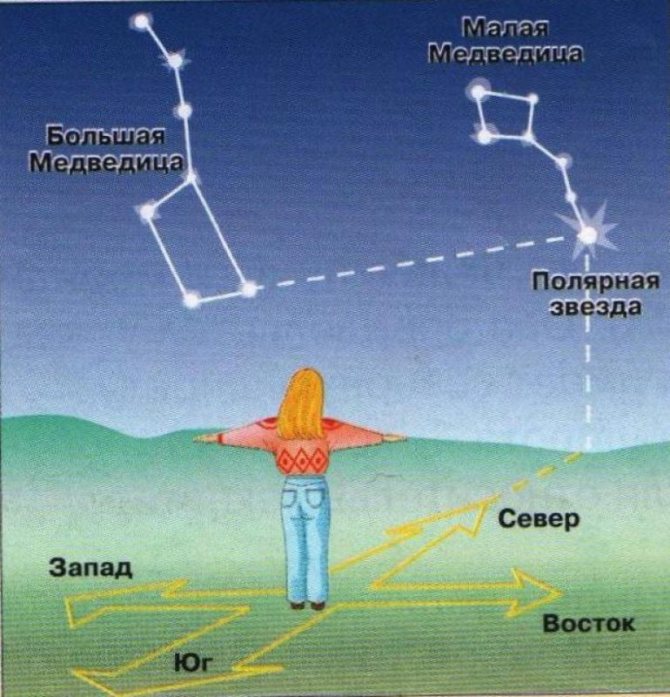
- Take 2 sticks, one of which is several centimeters longer than the other.
- They are stuck into the ground so that the larger one is slightly in front.
- Then they lie down and ensure that a straight line is formed between the stick and the gaze.
- As soon as any space object appears before your eyes, you need to observe its movement for several minutes.
- North will be to the left of the direction the object is moving.
- After this, they get up and look for a luminous figure in the north, consisting of several stars and resembling a small ladle.
- Mentally draw a curved line connecting the 2 right extreme points.
- They put 5 of the same segments up and get to the desired object.
Using a ruler
Kinosura, which is part of the constellation Ursa Minor, can be found using an ordinary school supply - a ruler. To do this, you need to follow a few simple steps. Among them should be the following:
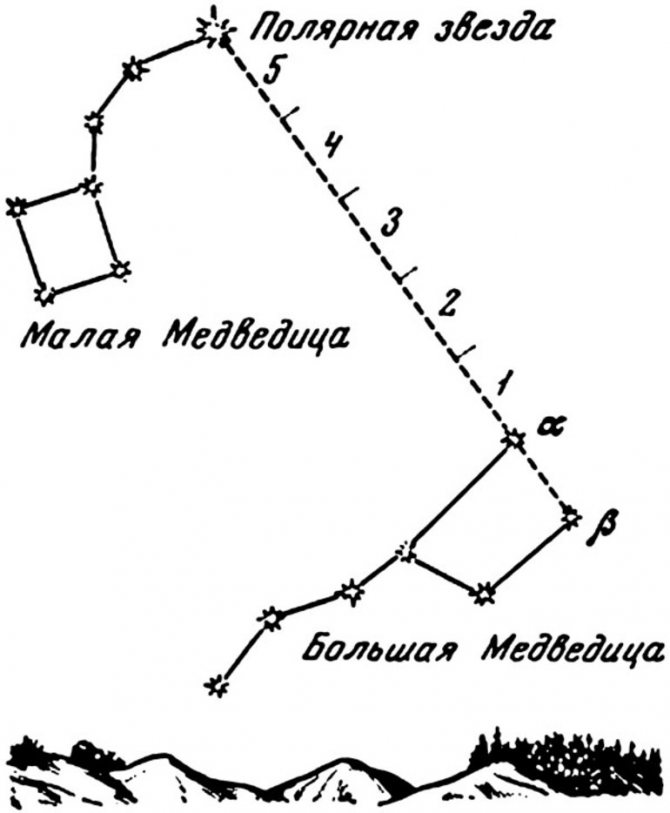
- Calculate the latitude of the area in which the star is being searched.
- Then, in any available way, determine the location of the north.
- After this, take a ruler and move it away from the eyes to a distance of 57 cm.
- The zero mark on the school supplies is aligned with the horizon line.
- 40.5 cm are laid upward. If everything is done correctly, then in this place you can see Alpha Ursa Minor.
According to various constellations
You can find the desired star in the night sky by focusing on the location of various constellations. These large star formations are quite easy to detect, so even beginners will not have any difficulties in this matter.
Methods of determination by various constellations:

- Cassiopeia. Before looking for Kinosura, you need to find the brightest star of Cassiopeia - Rukbach. In addition, the location of Mitnar in the constellation Ursa Major is determined. These space objects are connected by a conventional line that will pass through Polaris. In this case, it will be in the middle of the segment.
- Swan. To determine the position of Kinosura, it is necessary to draw a ray passing through Epsilon Cygnus (Denah) and Deneb. A distance is laid out on it, which is equal to double the length of the segment between the listed objects. As a result of these actions, the end of the line will point to the area of the sky in which Polaris will be the brightest star.
- Orion. The search for the desired star begins by mentally drawing a line from Alnilam (the middle element of Orion’s belt) through Meissa (the object at the top of the constellation). The length of the resulting segment is remembered and plotted from the brightest star in the constellation Auriga - Capella. At the end of the line you will be able to see the desired object.
If you have a compass
If you have a compass in your pocket, then finding Kinosura will be quite easy. Using it, it will be possible to determine the desired direction of movement, which will lead a lost person out of the forest. It should be taken into account that the North Star points to the north, and the south can be determined by turning 180 degrees. If you need to go east, just move to the right, and to go west, just move left.
Step-by-step instruction:
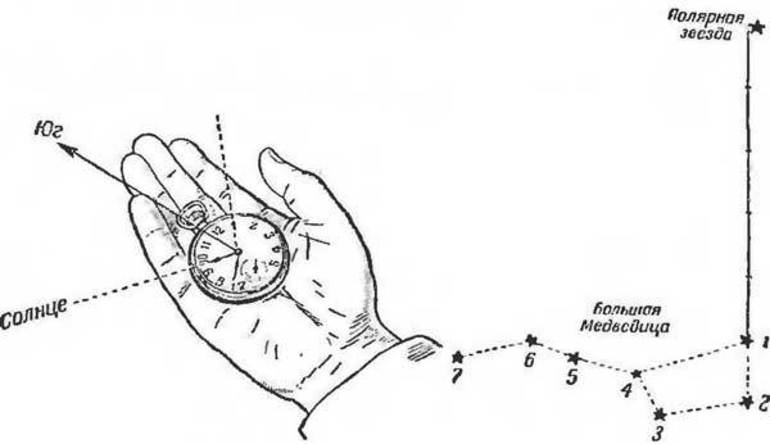
- Use a compass to determine north. This work should be performed away from railroad tracks, power lines, and vehicles. Otherwise, the device readings will be inaccurate.
- Corrections are made to the data obtained due to the divergence of the magnetic and geographical poles.
- Having accurately determined the northern direction, they begin the search for Polaris. To do this, use any of the known methods.
Landmark by the star Cygnus
The method of searching for the North Star using Cygnus can hardly be called simple, although it is also considered very effective. Its main difficulty is that not everyone finds the Swan in the night sky the first time. However, if you know exactly how to find it, determining the north direction will not cause difficulties, even if part of the sky and the North Star itself are hidden behind the clouds (Figure 6).

Figure 6. Searching for the constellation Cygnus is considered difficult
To do this, you need to find the two lowest points of the cluster: Hyena and Deneb. You need to draw a visual line between them. A segment is laid from Deneb, the length of which must correspond to two distances between the lower luminaries. At the end of this line the brightest point in the Northern Hemisphere is found.
Information about the space object
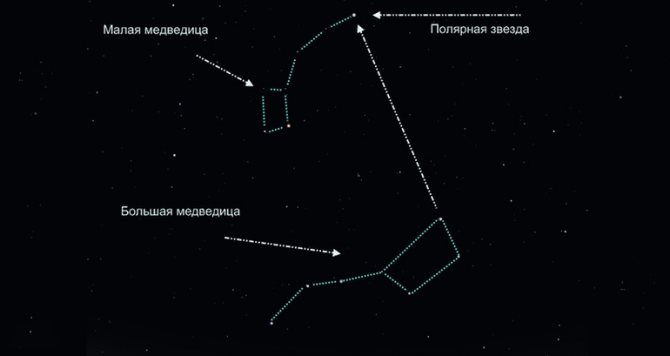
The polar star (other names are Polaris and Kinosura) is a huge space object that is located at a distance of several hundred light years from Earth. This makes it a fairly dim object in the night sky, making the search process difficult.
The North Star is located in the constellation Ursa Minor , located near the North Pole. It is a triple star system with a supergiant at its center. Astronomers highlight the following important features of the North Star:
- 48th brightest in the sky;
- is located at a distance of 447 light years from Earth;
- the size is 50 times greater than the Sun, and the mass is 6.5;
- the approximate age of the object is 60 million years.

The polar star was discovered several thousand years ago , but at that time its location was in no way connected with the celestial pole. About 14 thousand years ago, its place was occupied by Vega (the constellation Lyra). However, the constant movement of space objects and the displacement of the earth's axis led to the fact that Polaris gradually took the position that is known in our time.
The supergiant from the constellation Ursa Minor continues to shift, so in a few hundred years it will not be associated with the North Pole of the planet. In 3200, Kinosura will give way to the star Alrai (constellation Cepheus). In about 25 thousand years, the cycle of motion that began in 1110 AD will end, which will lead to the reappearance of Polaris at its zenith.
Search by Orion
Finding the North Star using Orion is also difficult, although it is quite possible with certain skills. This method will help with orientation if part of the sky is covered with clouds and it is difficult to find the north (Figure 7).
To do this, you will need not only Orion's belt, but also its extreme point - Capella. To do this, you need to draw a visual beam through the center of the belt, or more precisely, through the star Meissa. This section is then extended to the Capella and beyond. At the end of such a visual line the North Star will be located.

Figure 7. Orion searches are carried out only in autumn and winter
It is important that this method can only be used in autumn and winter. It is at this time of year that parts of Orion and the Polar Point are located at a distance from each other that allows one to determine the north. Moreover, the belt appears in the sky in the Northern Hemisphere only at this time of year.
